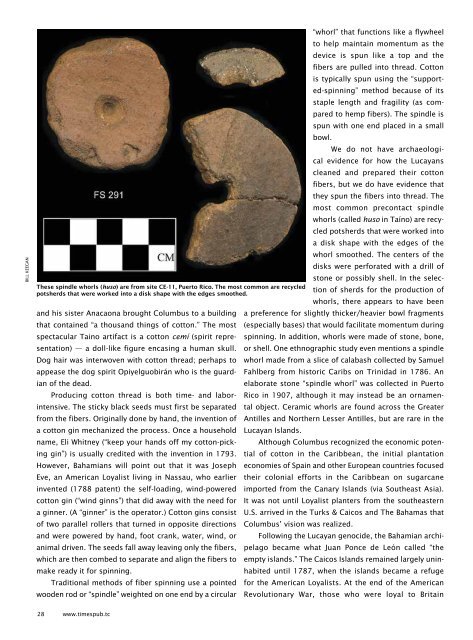Times of the Islands Fall 2022
Presents the "soul of the Turks & Caicos Islands" with in-depth features about local people, culture, history, environment, real estate, businesses, resorts, restaurants and activities.
Presents the "soul of the Turks & Caicos Islands" with in-depth features about local people, culture, history, environment, real estate, businesses, resorts, restaurants and activities.
Create successful ePaper yourself
Turn your PDF publications into a flip-book with our unique Google optimized e-Paper software.
BILL KEEGAN<br />
These spindle whorls (huso) are from site CE-11, Puerto Rico. The most common are recycled<br />
potsherds that were worked into a disk shape with <strong>the</strong> edges smoo<strong>the</strong>d.<br />
and his sister Anacaona brought Columbus to a building<br />
that contained “a thousand things <strong>of</strong> cotton.” The most<br />
spectacular Taino artifact is a cotton cemí (spirit representation)<br />
— a doll-like figure encasing a human skull.<br />
Dog hair was interwoven with cotton thread; perhaps to<br />
appease <strong>the</strong> dog spirit Opiyelguobirán who is <strong>the</strong> guardian<br />
<strong>of</strong> <strong>the</strong> dead.<br />
Producing cotton thread is both time- and labor-<br />
intensive. The sticky black seeds must first be separated<br />
from <strong>the</strong> fibers. Originally done by hand, <strong>the</strong> invention <strong>of</strong><br />
a cotton gin mechanized <strong>the</strong> process. Once a household<br />
name, Eli Whitney (“keep your hands <strong>of</strong>f my cotton-picking<br />
gin”) is usually credited with <strong>the</strong> invention in 1793.<br />
However, Bahamians will point out that it was Joseph<br />
Eve, an American Loyalist living in Nassau, who earlier<br />
invented (1788 patent) <strong>the</strong> self-loading, wind-powered<br />
cotton gin (“wind ginns”) that did away with <strong>the</strong> need for<br />
a ginner. (A “ginner” is <strong>the</strong> operator.) Cotton gins consist<br />
<strong>of</strong> two parallel rollers that turned in opposite directions<br />
and were powered by hand, foot crank, water, wind, or<br />
animal driven. The seeds fall away leaving only <strong>the</strong> fibers,<br />
which are <strong>the</strong>n combed to separate and align <strong>the</strong> fibers to<br />
make ready it for spinning.<br />
Traditional methods <strong>of</strong> fiber spinning use a pointed<br />
wooden rod or “spindle” weighted on one end by a circular<br />
“whorl” that functions like a flywheel<br />
to help maintain momentum as <strong>the</strong><br />
device is spun like a top and <strong>the</strong><br />
fibers are pulled into thread. Cotton<br />
is typically spun using <strong>the</strong> “supported-spinning”<br />
method because <strong>of</strong> its<br />
staple length and fragility (as compared<br />
to hemp fibers). The spindle is<br />
spun with one end placed in a small<br />
bowl.<br />
We do not have archaeological<br />
evidence for how <strong>the</strong> Lucayans<br />
cleaned and prepared <strong>the</strong>ir cotton<br />
fibers, but we do have evidence that<br />
<strong>the</strong>y spun <strong>the</strong> fibers into thread. The<br />
most common precontact spindle<br />
whorls (called huso in Taíno) are recycled<br />
potsherds that were worked into<br />
a disk shape with <strong>the</strong> edges <strong>of</strong> <strong>the</strong><br />
whorl smoo<strong>the</strong>d. The centers <strong>of</strong> <strong>the</strong><br />
disks were perforated with a drill <strong>of</strong><br />
stone or possibly shell. In <strong>the</strong> selection<br />
<strong>of</strong> sherds for <strong>the</strong> production <strong>of</strong><br />
whorls, <strong>the</strong>re appears to have been<br />
a preference for slightly thicker/heavier bowl fragments<br />
(especially bases) that would facilitate momentum during<br />
spinning. In addition, whorls were made <strong>of</strong> stone, bone,<br />
or shell. One ethnographic study even mentions a spindle<br />
whorl made from a slice <strong>of</strong> calabash collected by Samuel<br />
Fahlberg from historic Caribs on Trinidad in 1786. An<br />
elaborate stone “spindle whorl” was collected in Puerto<br />
Rico in 1907, although it may instead be an ornamental<br />
object. Ceramic whorls are found across <strong>the</strong> Greater<br />
Antilles and Nor<strong>the</strong>rn Lesser Antilles, but are rare in <strong>the</strong><br />
Lucayan <strong>Islands</strong>.<br />
Although Columbus recognized <strong>the</strong> economic potential<br />
<strong>of</strong> cotton in <strong>the</strong> Caribbean, <strong>the</strong> initial plantation<br />
economies <strong>of</strong> Spain and o<strong>the</strong>r European countries focused<br />
<strong>the</strong>ir colonial efforts in <strong>the</strong> Caribbean on sugarcane<br />
imported from <strong>the</strong> Canary <strong>Islands</strong> (via Sou<strong>the</strong>ast Asia).<br />
It was not until Loyalist planters from <strong>the</strong> sou<strong>the</strong>astern<br />
U.S. arrived in <strong>the</strong> Turks & Caicos and The Bahamas that<br />
Columbus’ vision was realized.<br />
Following <strong>the</strong> Lucayan genocide, <strong>the</strong> Bahamian archipelago<br />
became what Juan Ponce de León called “<strong>the</strong><br />
empty islands.” The Caicos <strong>Islands</strong> remained largely uninhabited<br />
until 1787, when <strong>the</strong> islands became a refuge<br />
for <strong>the</strong> American Loyalists. At <strong>the</strong> end <strong>of</strong> <strong>the</strong> American<br />
Revolutionary War, those who were loyal to Britain<br />
28 www.timespub.tc
















